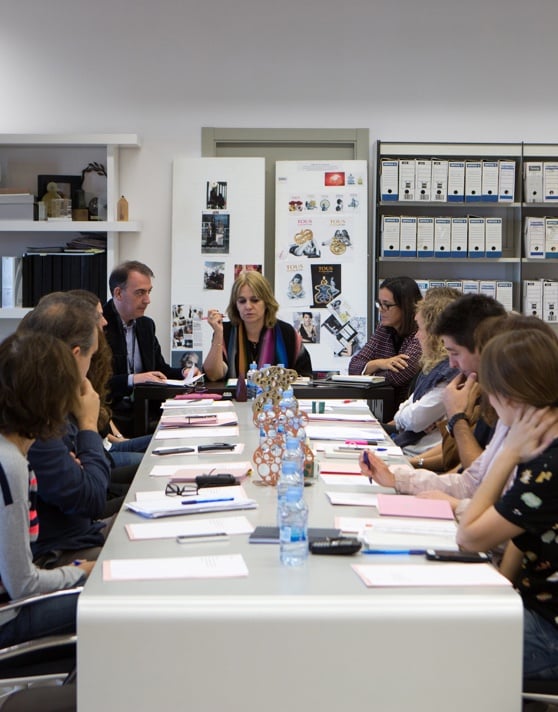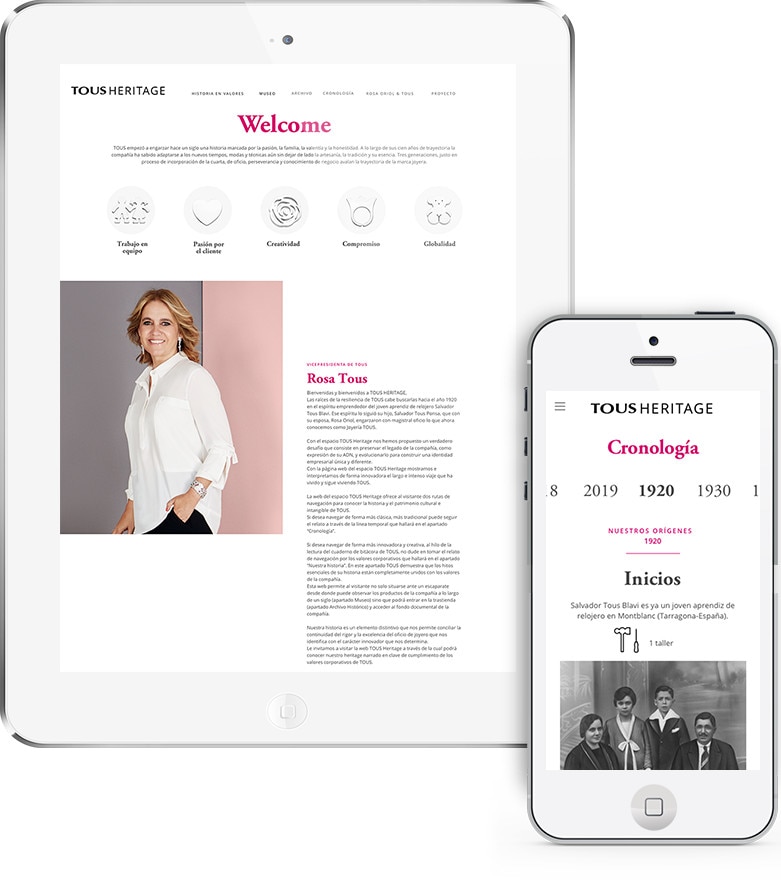Project
TOUS Heritage is designed to be a meeting place, open to all and under ongoing construction, where customers, employees and society as a whole can share, experience, inspire, and forge relationships as they travel through the company's past, present and future.
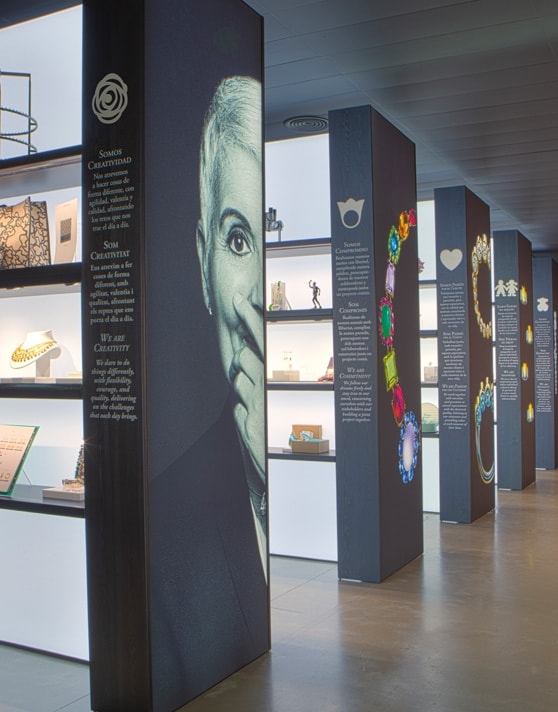
Exhibition area for the TOUS Heritage Museum. Joyería TOUS, S.A. fonds
Project context and definition.
TOUS Heritage is the result of the development of the global system for the conservation, use and communication of the historical heritage (Enterprise heritage) of TOUS JEWELRY, S.A.
Project context.
The TOUS Heritage project creation strategy should be understood in the context of the company’s values. The aim of TOUS Heritage is to present TOUS’ historical trajectory with real-life examples through a creative and innovative narrative, giving the company the opportunity to communicate its corporate identity and to differentiate itself within the sector.
Project definition.
The parameters that define the TOUS HERITAGE project are:
Vision.
To recognize TOUS’ historical business heritage as an important element of the company, which can be integrated as an intangible asset.
Mission.
To document, inventory, promote and give value on TOUS’ historical business heritage based on artisan tradition, excellence, emotion and innovation.
Values.
Global perspective of the heritage concept / Innovation / Use of IT and communication / Professionalism / Global Responsibility focus / Sustainability
Goals.
Preserve the corporate memory and identity by promoting research, conservation, dissemination and value of TOUS’ historical enterprise heritage. "Promote new uses (economic, social, cultural, etc.) of TOUS’ historical industrial heritage assets under social responsibility criteria. To promote knowledge about the evolution of the design, manufacture, social use etc. of products from our immediate past and of our sociocultural history through the historical business heritage of TOUS." To enhance the use of IT and innovation activities and transference of knowledge through the documentation and dissemination of TOUS’ historical legacy.
Work team.
TOUS Heritage is the result of teamwork from the company’s departments, relevant people in the company’s history and the project promoter team.
The starting point for team training has been to interrelate and integrate the different perspectives, needs and expectations of all stakeholders in order to achieve a truly corporate project.
Leadership of the TOUS Heritage project comes from the Corporate Communication Department (formed by the corporate vice-president, Rosa Tous Oriol, the head of corporate Communication, Teresa Copano López and the corporate Archives technician, Anna Mas Espinalt).
The design, planning and implementation of the project is part of the role of the Technical Directorate of the project (formed by Professor Jordi Andreu i Daufí, of the Facultat d’Informació i Mitjans Audiovisuals of the University of Barcelona and Carmen García Meilán, project technician).
The contribution of materials for the construction of the project and the advice on the contextualization of the business activity is the function of the TOUS HERITAGE Project Commission (formed by representatives of different company departments).
The execution of architectural and material development for communication of contents is respectively under the control of the Projects and Marketing departments.
TOUS corporate values.
Project design criteria.
TOUS HERITAGE is a corporate project and for that reason the design criteria are determined by the purpose of the company. The objective of the project is to be a useful tool to substantiate the corporate entity and at the same time be an attractive product to aid dissemination. Corporate values act as the backbone to the TOUS HERITAGE narrative. Fulfillment of corporate values cannot be based on mere perception, or an internal or external point of view. As in any business activity, speculation should be replaced by demonstrable evidence. TOUS HERITAGE allows the company to show the “footprints of its activity” throughout TOUS’ history.
These “footprints” can be explained in a more traditional way, like a story through the timeline of events (chronological sequence) or in a more innovative way, as is the case of TOUS HERITAGE, which highlights essential milestones in TOUS’ history and how company values were fulfilled.
If someone is interested in learning about TOUS history, they can easily browse TOUS HERITAGE and, as if they were standing in front of a store window or taking a peek in the backroom (Historical Archives database), they can search through any information they wish to see.
Project development method.
TOUS HERITAGE was developed between February 2015 and December 2019 and has essentially been structured in two stages led by an internal communication stage of the project. The following is a summary of the project development stages, technical characteristics and other links:
Stage 0: Initial stage: Project communication.
DeliverablesProject communication plan that explains the guidelines and strategies at a corporate level for the TOUS HERITAGE project.
Stage 1: Inventory of background documents and museum collection.
· Stage A: Identification of producers · Stage B: Development of the classification system · Stage C: Production of the system for describing documentation and objects · Stage D: Installation of documentation and objects
DeliverablesCatalog of Archives authorities and collection Book of the classification of the Archivess and collection [company functions and activities taxonomy] Map of documentary series Computerized catalog of documentation and objects Preparation of the space and physical equipment for the storage of documentation and objects Management process manual for TOUS Heritage documents
Stage 2: Creation of the TOUS Heritage space.
· Stage A: Previous research on the museum project · Stage B: Development of the museum project · Stage C: Sample set up
DeliverablesProcess manual for TOUS HERITAGE document and object scanning Computerized catalog of documentation and objects: database and image association TOUS Heritage historical business website Permanent virtual exhibition of TOUS’ historical industrial heritage
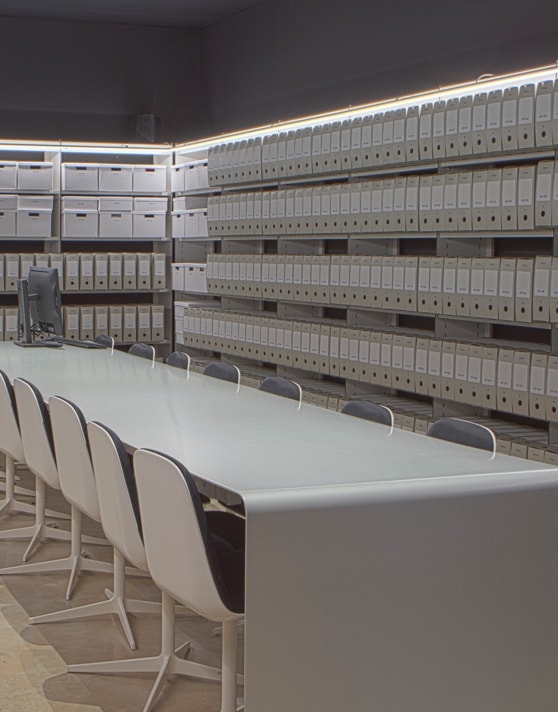
TOUS History. Consultation room and deposit. Joyería TOUS, S.A. fonds
Project results.
The TOUS HERITAGE project has achieved the planned objectives and these have been accomplished in three categories of results (outputs):
• Creation and implementation of the company’s semi-active and historical documentation and object management subsystem. • Virtual space creation: TOUS HERITAGE website • Creation of physical space: TOUS Jewelry Museum and Archives
Creation and implementation of the company’s semi-active and historical documentation and object management subsystem.
The setting up of TOUS HERITAGE has led to the creation and implementation of a part of the company’s document management system: the documentation management and semi-active and historical object (SGDOSH).
For the implementation of SGDOSH the company has created and has equipped specialized personnel for the Corporate Historical Archives that, together with the project Technical Directorate, have designed and implemented the automation of processes and procedures of the management subsystem for semi-active and historical (SGDOSH) documentation and objects.
With regard to the automation of the technical process, the TOUS HERITAGE project has laid out a strategy based on the integration, interoperability and the ease of scaling the selected technology within the framework of the company’s information system. To this end, SharePoint technology for the document management of TOUS HERITAGE has been adopted.
The tool has been prepared to:• Use the function options offered by default (collaboration, document management, security…) without creating a specific application for TOUS HERITAGE.
• Use it as a resource to manage and store documentation that contains the company’s semi-active and historical files.
• Control access to documentation by defining profiles that delimit the actions that can be performed by the systems user.
• Structure the organization of documentation by Archivess and series and manage them by departments.
• Regulate document life cycle. When certain conditions are met (document date, retention period, etc.) the documentation is transferred to a public area for consultation on the public website.
• Communicate, spread and use content in an integrated, accessible and usable way from the TOUS HERITAGE public website (e.g. direct access to the automated catalog of the company’s Historical Archives)
Virtual space creation: TOUS HERITAGE website.
The structure of the website consists of 6 spaces: History in values, Museum, Archives, Chronology, Rosa Oriol & TOUS and finally the present area project in which the TOUS HERITAGE project is defined.
In the History in values space and in compliance with the design criteria of the project, the visitor can access the story of the historical trajectory of TOUS with demonstrative evidence linked to our corporate values. This demonstrative evidence includes documents that throughout the company’s existence has generated and/or received and that are the result and proof of its business processes. However, companies do not always keep all the documents relating to their activity in their Archivess, especially the most incipient. It is sometimes necessary to use other institutions that keep this documentation. This research process has also occurred in this project and therefore documents whose typology and provenience are not normally found in a company’s documentary Archivess will appear in History values.
In the Museum space, the visitor will be able to get to know the objects that make up the TOUS museum collection. The virtual tour of the TOUS museum collection can be done with the same approach as the TOUS story. The proposed itinerary offers the visitor a chance to see exhibits highlighting corporate values and the most significant milestones of the company’s development. If the visitor prefers to browse freely, they can access items in each collection and the technical information about each of them.
TOUS’ drive to deploy this corporate communication product would not have been possible without the ability to demonstrate that what it says is based on real, verifiable and accessible documentary records. This is the function of the Archives space in which the visitor can access the documents through the Historical Archives database and, therefore, the origin of the sources of the TOUS story.
As previously explained, the strategy for automating the archival technical process in the TOUS HERITAGE project has been designed under the criteria of integration, interoperability and ease of browsing the selected technology within framework of the company’s information system. To this end, SharePoint (Microsoft) technology has been adopted and adapted not only for document management but also for access and dissemination of these documents (EmpathyBroker search engine) by online visitors. The function design has, of course, been based on international standards: classification (IS0 15489) and description and management (ISA(G) - ISAAR (CPF) - ISO 23081) and has been chosen for dissemination by the transformation to standardized formats (PDF – JPEG – MP4) of the original documents.
In the Chronology space, unlike the History in values space, the online visitor is shown the milestones of the company’s life within a variable timeline. The chronology of TOUS HERITAGE has the possibility not only to facilitate the understanding and the location of relevant moments of the company, but also to allow an understanding of the trends of its evolution in a synthetic and simple way.
Rosa Oriol & TOUS area. "In 1965, Rosa Oriol married Salvador Tous. They started a family together and turned a small family jewelry business into a global company and a coveted brand around the world." Understanding the global vision of TOUS would be impossible without Rosa Oriol. If there is anyone that has dared to do things differently with agility, courage and a drive for quality throughout their professional career, it has been Rosa Oriol. In 2016, Rosa Oriol released what is known as one of her greatest creations, the Rosa Oriol & TOUS book, commemorating her golden wedding anniversary. Similar to what happened in 2002 with the Kaos handbags, the creative process of the book has been a stimulus that has resulted in the TOUS HERITAGE project.
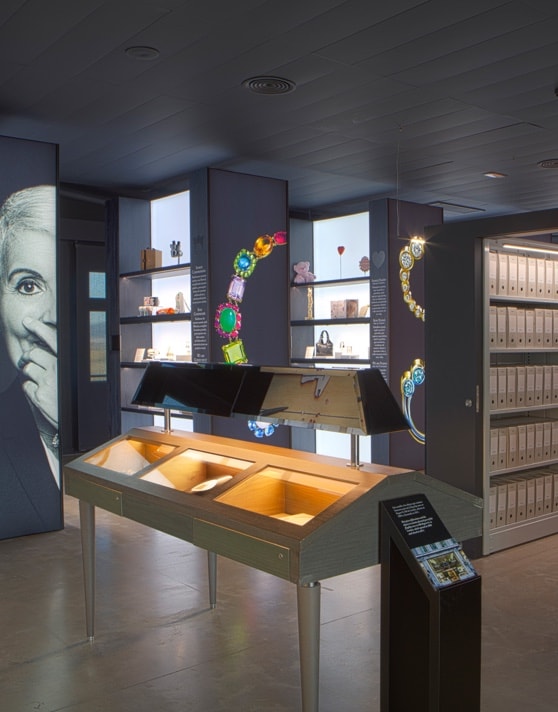
TOUS Heritage Museum exhibition area. Joyería TOUS, S.A. fonds
Creation of the physical space: TOUS Jewelry Museum and Archives
By creating the physical space for the Museum and Archives, TOUS has given shape to the spirit of the company’s service to its customers, employees and society in general. The goal of this space is to share, experiment, inspire and immerse employees, customers and researchers of the company’s past, present and future for the greater understanding of it.
"Access to TOUS Museum and Archives" To achieve the Museum’s goal of immersing the visitor in the essence of the company, a thorough design has been created to present the story with key experiences. In this space, the object itself is the protagonist and the message that it transmits. The exhibition area, while having conditioning elements, does not detract from the main purpose. The environment, furniture etc. have been specifically designed to blend into the background so as not to distract from the main objective and its message.
The organization of the collection has not been based on chronological criteria, by product or material, but by corporate values identified by iconic products of the brand. The reason, as has already been explained in great detail, is that the history and production process of the company is understood to be complex and interrelated, and the products and events cannot be restricted to defined categories but rather the visitor should be able to contextualize the object within the story. "The Museum and Archives have also been created as a tool in the process of welcoming a new employee. Having a global view of the company, its activities, its milestones and its goals allows a new employee to understand, contextualize and understand their role required and the role of their colleagues as well as getting to know what the company expects of them." "Understanding this tool facilitates the participation and involvement of the team in the process of creating new ideas and products based on the wealth of information provided by the corporate Museum and Archives." The Historical Archives is a company resource, one that is a source of information that produces profit, which is available to all employees and researchers, created under contemporary professional standards and parameters and has been integrated into the system of company information technologies.

